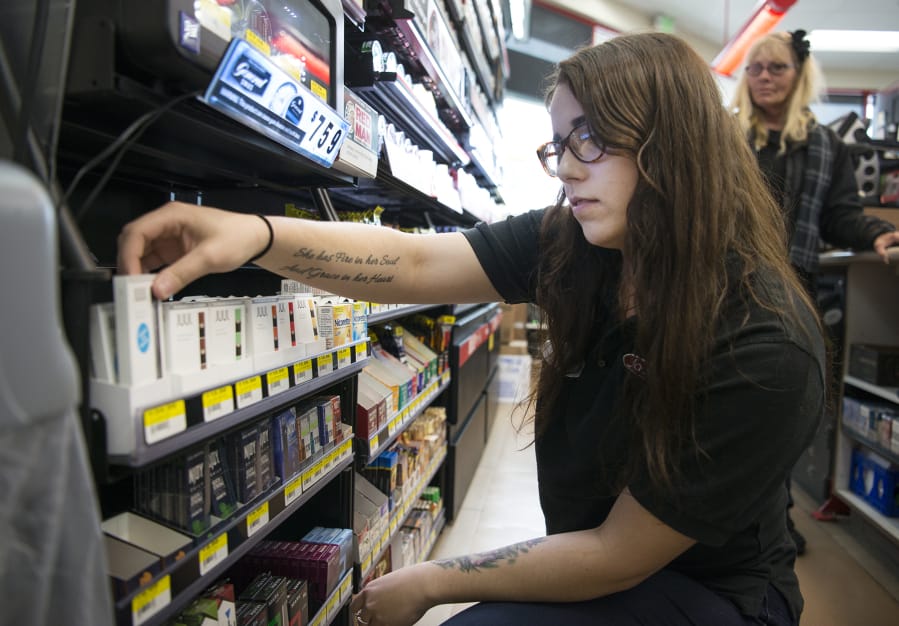Teenagers smoking behind the bleachers may be a thing of the past, but health officials say teens are still using nicotine. The latest method: “juuling” in school bathrooms.
“Juul is just kind of the new trend right now that’s taking off,” said Stacia Wasmundt, youth tobacco and vapor product prevention consultant at the state Department of Health.
Juul is an electronic cigarette that looks like a USB device and features liquid nicotine “pods” with flavors like mango and créme brulée. The body of the Juul device contains the battery, temperature regulator and sensors to detect battery level and when a user is vaping. The pods, which contain a coil to heat the liquid, click into the top of the device and serve as the mouthpiece. The pods are disposable, and the device is recharged using a magnetic USB charger.
The devices have grown in popularity since hitting the market in 2015. Recent reports show Juul has 55 percent of the electronic cigarette market share.
“It’s the most popular product right now,” Wasmundt said.
And its popularity extends to youth. State health officials have heard from districts across the state. The consensus, Wasmundt said, is Juuls are in schools. Teens reveal that’s true even at schools where adults don’t see Juul devices, she said.
The innocuous appearance of the devices mean teachers and other school staff may not realize the devices are harmful, Wasmundt said. But students are using the devices, oftentimes in school bathrooms, and then easily concealing them in the palm of their hands, she said.
The flavored nicotine pods are also appealing to teens, Wasmundt said, as is the ability to customize the devices with colorful wraps, or skins, sold through various online retailers.
“There’s certain vapor products they say are the iPhone of vapor products,” Wasmundt said, “and this is one of them.”
Battle Ground Public Schools officials say they are aware of Juul devices and see them more frequently among teens. Spokeswoman Rita Sanders said district intervention specialists are concerned by Juul use because not only are the devices a vehicle for nicotine, but other compounds in the liquid are likely harmful to young lungs. In addition, the pods can be altered to contain THC instead of nicotine, she said.
The district is educating students, teachers and staff about the devices. School officials confiscate the devices, per the district’s drug and alcohol policy, and students caught with them are subject to corrective action, Sanders said.
Evergreen Public Schools officials say they’ve seen little evidence of Juul devices in the district’s schools. A review of security reports shows only one mention of Juuls — a discarded device found in a parking lot last year, said district spokeswoman Gail Spolar.
Youth use of Juul devices is particularly troubling for health officials because of the Juul pods’ high nicotine levels. Each pod is 5 percent nicotine and is equivalent to a pack of cigarettes.
On its website, Juul touts its use of nicotine salts, as found in the tobacco leaf, rather than free-base nicotine used in standard e-cigarettes, as well as its cigarettelike nicotine levels.
But the nicotine levels also make the device particularly dangerous for young, developing brains, Wasmundt said.
Research has shown adolescence is a sensitive period for maturation of brain circuits that regulate cognition and emotion. Research has also shown that nicotine changes the pathways in developing brains and affects dopamine levels.
The brain is particularly vulnerable during this period to the effects of nicotine and is more susceptible to addiction, Wasmundt said.
And while the sale of the devices is restricted to adults 18 and older, teens are still getting their hands on them.
“We know kids are getting these from their friends who are 18, 19, 20 years old,” Wasmundt said. “It’s easy to get them. That’s what we hear all over the state.”
That’s why state health officials are pushing for legislation to raise the minimum age to purchase electronic vaping devices and cigarettes to 21. A bill to raise the age passed the House this year, but its companion in the Senate failed to garner enough support.
“We have to break the cycle of addiction,” Wasmundt said. “And that starts with raising the minimum sales age to 21.”




